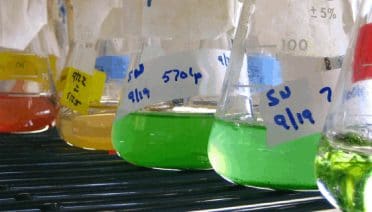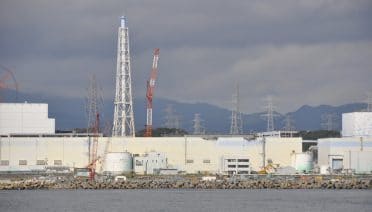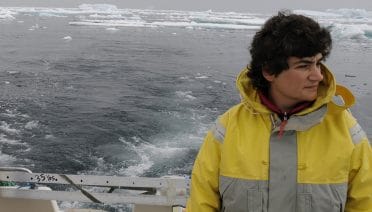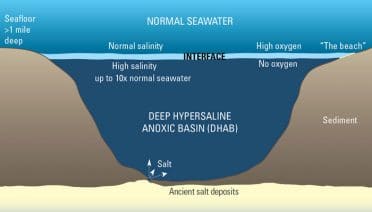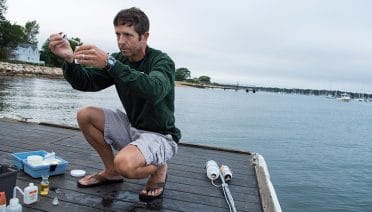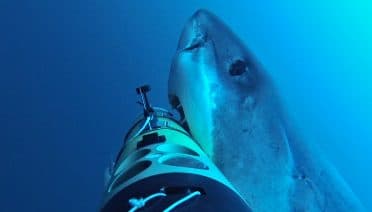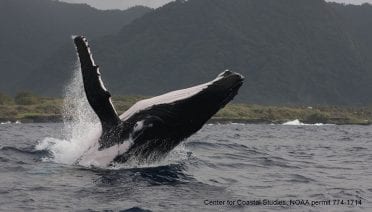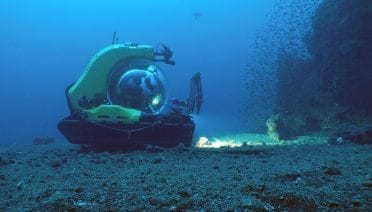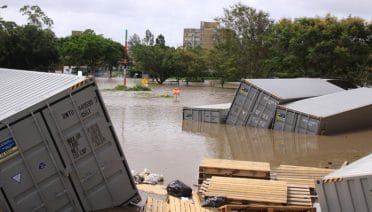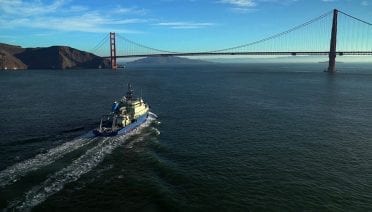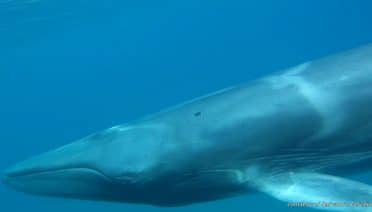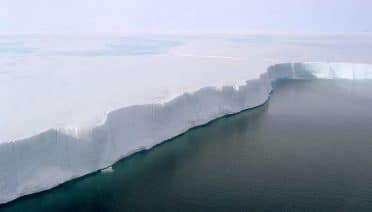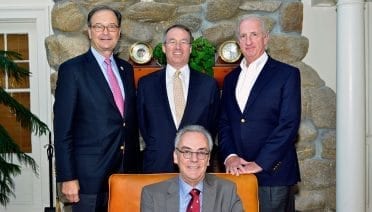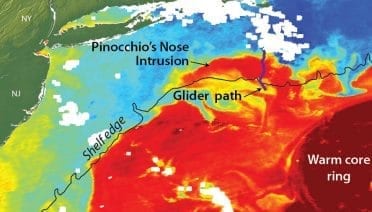Press Room
Scientists have long known methanol exists in the ocean, and that certain microbes love to snack on it, but they’ve been stymied by one key question: where does it come from? Researchers at WHOI have solved this mystery through the discovery of a massive ‘ and previously unaccounted for ‘ source of methanol in the ocean: phytoplankton.
Five years after the Fukushima accident, scientific data about the levels of radioactivity in the ocean off our shores are available publicly thanks to ongoing efforts of independent researchers, including WHOI radiochemist Ken Buesseler, who has led the effort to create and maintain an ocean monitoring network along the U.S. West Coast.
The American Geophysical Union (AGU) has chosen Fiamma Straneo, a physical oceanographer at Woods Hole Oceanographic Institution (WHOI), to deliver the Sverdrup Lecture at this year’s meeting of the Ocean Sciences section held in New Orleans from February 21-26, 2016. The lecture is one of the highest awards the section bestows on its members.
In 2010, a research team garnered attention when it published evidence of finding the first animals living in permanently anoxic conditions at the bottom of the sea. But a new study, led by scientists at the Woods Hole Oceanographic Institution…
Utilizing 22 years of data collected by a network of citizen scientists, researchers from the Woods Hole Oceanographic Institution (WHOI) and their colleagues at the Buzzards Bay National Estuary Program, the Buzzards Bay Coalition, and the Marine Biological Laboratory found that average summertime temperatures in embayments throughout Buzzards Bay warmed by almost 2 degrees Celsius—roughly 4 degrees Fahrenheit.
The dramatic video footage of a great white shark attacking the “REMUS SharkCam” autonomous underwater vehicle (AUV) brought some of the highest ratings to Discover Channel’s Shark Week 2014 and went viral on the Internet.
But while the footage was unprecedented, the scientific understanding enabled by the REMUS SharkCam is just as groundbreaking. The AUV was used during a science expedition in 2013 to better understand white shark behavior and represents the first successful efforts to autonomously track and image any animal in the marine environment. The research provides critical data to efforts to conserve these animals.
“We wanted to test the REMUS SharkCam technology to prove that is was a viable tool for observing marine animals – sharks in this case – and to collect substantial data about the animals’s behavior and habitat,” said WHOI engineer Amy Kukulya, one of REMUS SharkCam’s principal investigators.
The research results were recently published in the Journal of Fish Biology. The paper’s lead author is Greg Skomal, a biologist with the Massachusetts Division of Marine Fisheries. In addition to Kukulya, co-authors include biologist E. M. Hoyos-Padilla of Pelagios-Kakunjá, a Mexican marine conservation organization, and WHOI engineer and REMUS SharkCam software developer Roger Stokey.
Amy Apprill, a microbiologist at the Woods Hole Oceanographic Institution (WHOI), is one of the extraordinary women scientists featured in Science Magazine’s online video series, “XX Files: Extraordinary Science, Extraordinary Women.” The eight-part series, which highlights diverse projects led by a group of impressive female scientists, began in early October. The video featuring Apprill’s work, “The Humpback Microbiome,” debuts on December 15 and is the last in the special series.
In a paper published online Dec. 9, 2015, in Marine Mammal Science, a research team led by the Woods Hole Oceanographic Institution (WHOI), has for the first time quantified the amount of drag on entangled whales that is created by towing fishing gear, such as rope, buoys, and lobster and crab traps. The study provides important data for teams evaluating the risks and benefits of whale disentanglements.
During a three-week expedition in August, an international team led by the Woods Hole Oceanographic Institution (WHOI), in partnership with the Charles Darwin Foundation for the Galápagos Islands and in close collaboration with the Galápagos National Park Directorate, conducted the first scientific expedition to map and characterize the seamounts on the Galápagos platform and the diverse marine life that these underwater mountains support.
Scientists monitoring the spread of radiation in the ocean from the Fukushima nuclear accident report finding an increased number of contaminated sites off the US West Coast, along with the highest detection level to date, from a sample collected about 1,600 miles west of San Francisco. The level of cesium in the sample is 50 percent higher than other samples collected, but is still more than 500 times lower than US government safety limits for drinking water and well below limits of concern for direct exposure while swimming, boating, or other recreational activities.
Ken Buesseler, a marine radiochemist with the Woods Hole Oceanographic Institution (WHOI) and director of the WHOI Center for Marine and Environmental Radioactivity, was among the first to begin monitoring radiation in the Pacific, organizing a research expedition to the area just three months after the start of the ongoing accident. Through a citizen science sampling effort, Our Radioactive Ocean, as well as research funded by the National Science Foundation, Buesseler and his colleagues are using sophisticated sensors to measure minute levels of ocean-borne radioactivity from Fukushima. In 2015, they have added more than 50 new sample locations in the Pacific to the more than 200 previously collected and posted on the Our Radioactive Ocean web site.
A study by a team of U.S. and Australian researchers shows that long-term warming of the Indian and Pacific oceans played an important role in increasing the severity of the devastating floods that struck Australia in 2010/2011. The study was published in Geophysical Research Letters.
California welcomed the most recent addition to the US’s academic research fleet, the Neil Armstrong, as it made its first port of call in San Francisco over the weekend. The 238-ft., state-of-the-art ship made its way down the West Coast from Anacortes, Wash., where it was built.
In a paper published October 14, 2015, in the Royal Society Open Science journal, the researchers describe the whales’ foraging and vocal behaviors, and habitat preferences in the shallow waters of coastal Madagascar.
New research published today projects a doubling of surface melting of Antarctic ice shelves by 2050 and by 2100 may surpass intensities associated with ice shelf collapse, if greenhouse gas emissions from fossil fuel consumption continues at the present rate.
Ice shelves are the floating extensions of the continent’s massive land-based ice sheets. While the melting or breakup of floating ice shelves does not directly raise sea level, ice shelves do have a “door stop” effect: They slow the flow of ice from glaciers and ice sheets into the ocean, where it melts and raises sea levels.
Today, the Board of Trustees of the Woods Hole Oceanographic Institution (WHOI) elected David B. Scully as the new chairman of the Board. Scully was elected to the WHOI Corporation in 2010 and to its Board in 2012. In addition to Scully’s appointment, Jefferson Hughes, Jr. has been elected vice chairman of the Board of Trustees, and Steven Hoch has been elected chairman of the WHOI Corporation.
Ocean robots installed off the coast of Massachusetts have helped scientists understand a previously unknown process by which warm Gulf Stream water and colder waters of the continental shelf exchange. The process occurs when offshore waters, originating in the tropics, intrude onto the Mid-Atlantic Bight shelf and meet the waters originating in the Arctic. This process can greatly affect shelf circulation, biogeochemistry and fisheries.
In 2006, scientists using satellite imagery observed an elongated body of warm water from a Gulf Stream warm-core ring intruding along the shelf edge, extending hundreds of miles from Massachusetts towards Cape Hatteras, NC.
“A lot of people were surprised by this,” said Weifeng ‘Gordon’ Zhang, associate scientist at Woods Hole Oceanographic Institution (WHOI), and lead author of the study published [today] in Geophysical Research Letters. “Normally, the Gulf Stream water, which is very warm and buoyant, doesn’t come in direct contact with the water on the continental shelf, which is much colder. There is a cascade of potential implications that need further study.”
A new data-logging tag, called the ITAG, developed at WHOI specifically for small and delicate invertebrates not only quantifies ocean conditions but also measures animals’ responses to their physical environments in high resolution.
King crabs may soon become high-level predators in Antarctic marine ecosystems where they haven’t played a role in tens of millions of years, according to a new study led by Florida Institute of Technology. “No Barrier to Emergence of Bathyal…
Following completion of successful acceptance trials, the nation’s newest research vessel, the Neil Armstrong, was officially turned over by the U.S. Navy on September 23 to the Woods Hole Oceanographic Institution (WHOI), which will operate the vessel as part of…
Archaeologists excavating the famous ancient Greek shipwreck that yielded the Antikythera mechanism have recovered more than 50 items including a bronze armrest (possibly part of a throne), remains of a bone flute, fine glassware, luxury ceramics, a pawn from an ancient board game, and several elements of the ship itself.
“This shipwreck is far from exhausted,” reports project co-Director Dr. Brendan Foley, a marine archaeologist with the Woods Hole Oceanographic Institution (WHOI). “Every single dive on it delivers fabulous finds, and reveals how the ‘1 percent’ lived in the time of Caesar.”
The shipwreck dates to circa 65 B.C., and was discovered by Greek sponge fishermen in 1900 off the southwestern Aegean island of Antikythera. They salvaged 36 marble statues of mythological heroes and gods; a life-sized bronze statue of an athlete; pieces of several more bronze sculptures; scores of luxury items; and skeletal remains of crew and passengers. The wreck also relinquished fragments of the world’s first computer: the Antikythera Mechanism, a geared mechanical device that encoded the movements of the planets and stars and predicted eclipses.
The 2015 expedition is part of a long-term research program at the site, which began in 2014. It was the first scientific excavation of the wreck, and launched the first comprehensive study of all of its artifacts. During the new multi-year program the team expects to recover artifacts and ancient artwork still buried in the seafloor, and recreate the history of the ship’s exquisite cargo and its final voyage.

